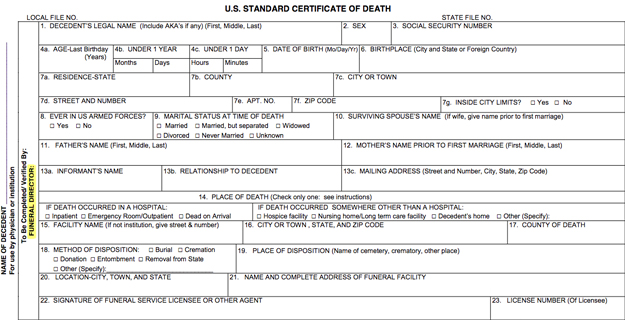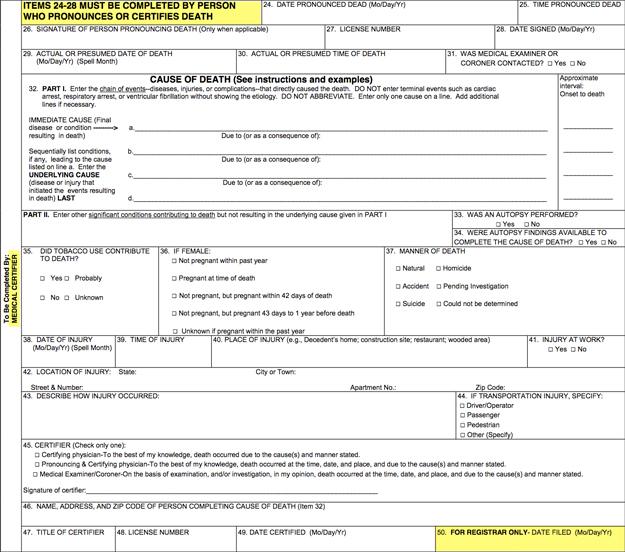Aug 08, 2018
Death Certificates: A Closer Look at Detail
Death certificates, collected since approximately 1904, are vital records with dedicated processes for completion and filing. According to the Social Security Administration, the funeral director will report the death. Depending on the jurisdiction, the funeral director might request additional certified copies in addition to the original certificate for families since it is a strategic legal document used in many after-death transactions, such as processing death and life insurance benefits, conducting bank account and property changes, and release of retirement funds. If allowed by jurisdictional law, a family member may also request a copy from the state, usually for a fee. At times, the death certificate serves as an important document for civil and criminal proceedings.
Though most states have an electronic registry, the death certification process varies from state to state. However, all states use the same form, the U.S. Standardized Certificate of Death. The certificate is divided into three sections. The first 23 fields (Figure 1) and the last five fields (Figure 2) collect information that ranges from the usual identifying statistics like name, age, and birthdate and place to educational achievement, and occupation. These fields are usually completed by the funeral director.


The document's remaining fields (Figure 3) are included under the section referred to as the "cause of death" section. These fields are dedicated to the "chain of events — diseases, injuries, or complications — that directly caused the death." Tobacco use is addressed in this section, as is the manner of death: natural, accidental, suicide, or homicide. "Could not be determined" or "pending investigation" are additional checkboxes for deaths because certification needs to be completed within several days of death. State laws also dictate who is eligible to complete this section, including individuals with formal medical training and others who don't. Certificates can be amended when information is available, again a process that varies from state to state.

According to the Centers for Disease Control and Prevention (CDC), the home of the National Center for Health Statistics (NCHS), the funeral director is not just responsible for completion of the first and third section, they are also often responsible for getting the death certificate's cause of death section completed by the jurisdiction's designees. From the funeral director, the death certificate takes a standardized path, going to the state's registrar at the office of vital statistics where the "date filed" is entered and the information eventually reaches the NCHS.
Experts said it's important to note that the death certification process is sometimes referred to the medicolegal system for review by medical examiners and coroners. Not all of these reviews include a post-mortem exam, but according to a 2016 National Science and Technology Council report, the medicolegal system completes nearly 500,000 autopsies and post-mortem exams annually. Most of these medicolegal reviews and exams are needed when natural death might be in question or for the other categories noted on the death certificate: accidental, suicide, homicide, indeterminate, or pending investigation. When families request an amended certification, these teams are also usually involved.
Medical examiners usually have a medical background; many are pathologists, or forensic pathologists with special training related to examining the decedent's physical and laboratory findings. According to experts, most coroner systems have on-the-job training and are either elected or appointed, depending on local statutes. The National Association of Medical Examiners (NAME) has a voluntary accreditation program for medical examiner/coroner offices.
The Vital Statistics Registration System in the United States for Death Certificates
Duties of each responsible person or agency
Funeral director
- Obtains personal facts about decedent and completes certificate.
- Obtains certification of cause of death from attending physician or medical examiner or coroner.
- Obtains authorization for final disposition per state law.
- Files certificate with local office or state office per state law.
Designated Professional Attendant
- Completes certification of cause of death and signs certificate.
Local office (local registrar; city or county health department; or if a state has no local vital registration offices, certificates transmitted directly to state office of vital statistics
- Verifies completeness and accuracy of certificate and queries incomplete or inconsistent certificates.
- If authorized by state law, makes copy or index for local use.
- If authorized by state law, issues authorization for final disposition on receipt of completed certificate.
- Sends certificates to state registrar.
City and county health departments
- Use data derived from these records in allocating medical and nursing services.
- Follow up on infectious diseases.
- Plan programs.
- Measure effectiveness of services.
- Conduct research studies.
State registrar, office of vital statistics
- Queries incomplete or inconsistent information.
- Maintains files for permanent reference and is the source of certified copies.
- Develops vital statistics for use in planning, evaluating, and administering state and local health activities and for research studies.
- Compiles health-related statistics for state and civil divisions of state for use of the health department and other agencies and groups interested in the fields of medical science, public health, demography, and social welfare.
- Sends data for all events filed to the National Center for Health Statistics.
National Center for Health Statistics, Centers for Disease Control and Prevention
- Evaluates quality of state vital statistics data and works with states to assure quality.
- Compiles national statistical data file and runs edits to fully process data.
- Prepares and publishes national statistics of births, deaths, and fetal deaths; constructs the official U.S. life tables and related actuarial tables.
- Conducts health and social research studies based on vital records and on sampling surveys linked to records.
- Conducts research and methodological studies in vital statistics methods, including the technical, administrative, and legal aspects of vital records registration and administration.
- Maintains a continuing technical assistance program to improve the quality and usefulness of vital statistics.
- Provides leadership and coordination in the development of standard certificates and report and model laws.
Source: CDC's
Funeral Directors' Handbook on Death Registration and
Fetal Death Reporting

